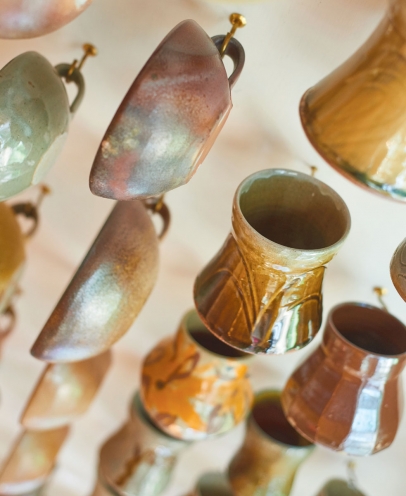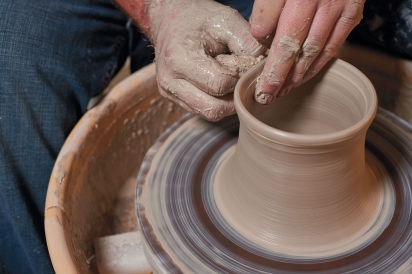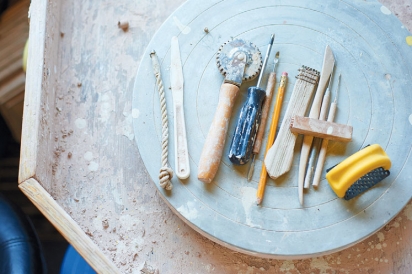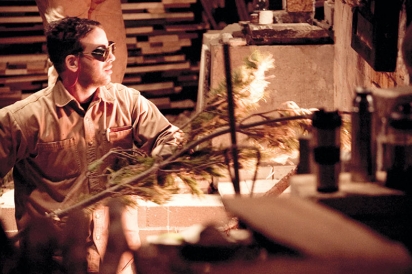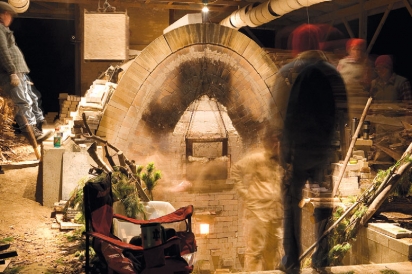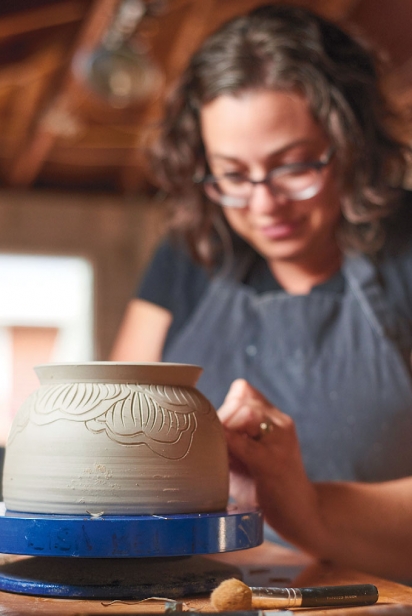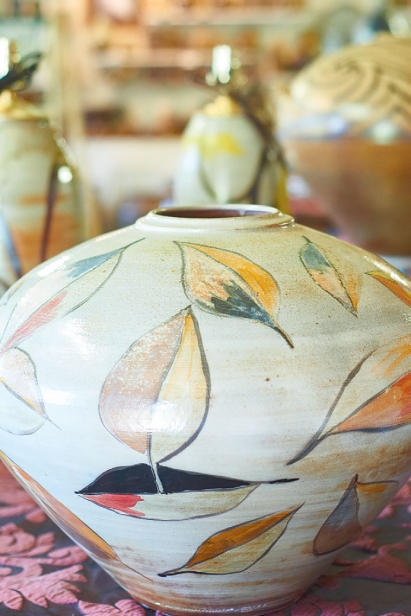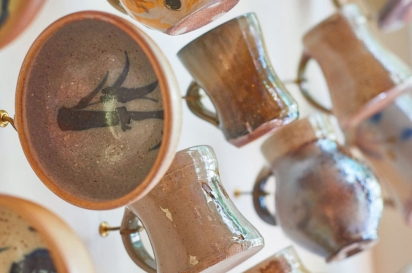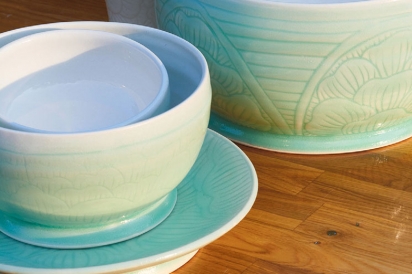A Craft Pottery Revival in Ohio
Mouthfeel describes the way food or drink feels in the mouth; the sensation of whipped cream on the tongue versus a bite of steak—two very different mouthfeels for very different reasons. Yet what if there was a word for the way the plate feels in your hands as you scoop chicken and biscuits onto it for dinner—platefeel—or the way your coffee mug feels in your hand— mugfeel—or the way a bowl feels nestled between two palms on a cloudy autumn morning when you’re having your oatmeal—bowlfeel?
We know an object is well designed when it feels so good to use it becomes an extension of our way of being. It’s both functional and beautiful and adds a certain grace to our mundane lives. These aspects of good dishware and kitchenware are concepts functional potters think about all of the time. As they throw clay and spin their potter’s wheel, they’re feeling their way to a good, functional, clay pot for your kitchen, or the restaurant down the street.
Ohio has a rich history of functional pottery. The state was once well known for the factories that made use of its abundant clay deposits along the Ohio River. East Liverpool in the 18th and 19th centuries was called the “Pottery Capital of the USA.” Westerville is home to the Edward Orton Jr. Ceramic Foundation industry founded in 1932 by Edward Jr., a pioneer in ceramics engineering who taught at The Ohio State University. Prior to starting the foundation, which provides products to assist the ceramic arts and industry, he developed pyrometric cones, which are used to measure the maturity of the clay in the kiln and determine the combined effects of heat on the clay over time (called heatwork). The cones, made of a blend of ceramic materials, are still used today, a staple among potters all over the world. Ohio has clay running through its veins.
Yet the majority of the pottery produced in Ohio during the 18th and 19th centuries was high volume ceramic production—lots of pots being shipped to lots of people. When industry and craftsmanship was displaced overseas to countries like China for cheaper manufacturing, Ohio, like so many other states in America, lost its edge. The disappearance of ceramic production in places like East Liverpool and Zanesville left regions of Ohio once booming with clay, and its offspring, like ghost towns of a time past.
“Ohio has historically been home to art potteries including Rookwood, Weller and Roseville, as well as larger industrial manufacturers. When industry declined here we went through a stage where the knowledge that those artisans had was not passed on to a new generation,” says Jessica Knapp, editor at Ceramics Monthly and associate editor of Pottery Making Illustrated based in Westerville. “The history of ceramics in Ohio has been more focused on factories and industry than other states like North Carolina or Minnesota, which have been more focused on small-scale production, independent artists with a studio or small potteries with master artist/owners and apprentices.”
History does not repeat itself when it comes to what is happening now with ceramic studio arts and craft pottery in Ohio. There is a renaissance among potters and pottery fans, well-known chefs, devoted home cooks, fermentation experts and coffee lovers to bring more of the handmade feel of a good functional pot, and the craft it takes to make it, back to Ohio by way of our kitchens, large and small. And it’s a trend that is taking shape nationwide.
“In the last few years companies like Starbucks have become interested in working with some of the established ceramics factories in Ohio to make smaller, limited-run production pieces that are made by hand,” says Jessica. “They’ve been able to restart production at certain factories and hire on more people because of the interest in handmade work and smaller batch runs. Some of the smaller factories that were once put out of business because of the production that moved overseas have been reopened under new ownership. So the interest in having things that are handmade and made in the USA has actually helped bring part of that industry back.”
And while companies like Starbucks are reinventing the handmade concept for corporate commerce, smaller potteries and individual artist studios are also benefiting from and influencing this renewed interest in handmade ware. The artisan ceramics movement (like so many innovators and visionaries) continues to steer aesthetics and functionality for the marketplace with independent potters devoted to the life-long challenge of making the perfect clay pot. There is an art form to your favorite mug, and behind the mug an artist in love with the world of clay.
Standing in the kitchen of Naysan
McIlhargey, owner of Miami Valley Pottery in Yellow Springs, Ohio, one can look up and find the ceiling covered in ceramic mugs collected from all over the world, hanging from little hooks. Naysan loves to have choice in the morning. “You can decide which mug you feel like from day to day,” he smiles, as he offers me a cup of coffee.
Naysan is from Yellow Springs and moved back after a circuitous route of studying ceramic studio arts at Earlham College, moving to the East Coast to apprentice with potters, meeting his wife, Jalana, and then returning to Ohio and establishing Miami Valley Pottery in 2004. He worked with Mike Theideman while at Earlham, a ceramist who trained with Warren MacKenzie, the man responsible for introducing the Leach tradition of pottery to America. Bernard Leach was one of the great artists of the 20th century—a world-renowned British potter and art teacher who had studied in Japan and believed in simple, functional forms for the everyday pot over more decorative, fine art clay pots.
The Leach tradition lives on in Naysan. “Functionality is very important to me, and because it’s so important it’s oftentimes difficult to put into words,” he laughs. “It’s important for a pot to be comfortable to hold, elegant, the proportions of the particular shape need to work together. Most importantly, it should feel comfortable.”
With comfort comes use. Naysan describes a recent dinner he prepared at home with Jalana for their friends in his newly erected ceramic pizza oven. They used four handmade pots from Naysan’s studio, threw seasonal vegetables in the vessels and roasted them. “It’s so nice to pull something out of the oven and enjoy looking at it while you’re eating,” he explains.
Every single pot from Miami Valley Pottery is hand-thrown and hand-decorated by Naysan. Yet throwing is only half the battle for the potter. The soft, moist clay molded into the desired shape has to then be fired in a kiln, which is like an oven for the clay pots, heating up and hardening the once tender form to a true pot you can use. Most potters use gas kilns, but Naysan is unique. He fires in a hand-built 450-cubic-foot wood kiln that requires two weeks to fully load the kiln, five days to fire the pots and multiple loads of wood to keep the fire burning to achieve a temperature of 2,400°. To meet his firing goals, he invites friends and neighbors from the community in Yellow Springs to stoke the fire with him, engendering a kindred circle of fire-builders who return year after year to help him produce his next line of pottery. Naysan’s mentors, Cary and Elaine Hulin of Holmes County Pottery, even come down to help him fire.
Naysan’s pottery embodies terroir, the taste of a place. Holding the mug I chose, I feel Naysan’s Yellow Springs spirit in its soft curves and muted colors. More specifically, I note the texture of the cup with its random patterning, a result of the wood-firing process. While Naysan loads multiple pots into his wood-fired kiln, each pot looks different in the end due to the wood ash deposited onto the vessels during the firing process. No two pots, truly, are the same.
People love the improvisatory nature of his work—his salt shakers are on every table at The Wind’s Café in Yellow Springs. Naysan collaborates with other restaurants in the region as well as in London, UK. Currently, he’s building a second, smaller gas kiln so he can fire more plates more consistently instead of just two times a year. He wants to work with other restaurants, close to home and as far as France, to marry his handmade pottery with the dining experience. It’s a trend taking shape across the country. Naysan knows a handful potters that are making their living exclusively from catering their dinnerware and service items to chefs and restaurants.
“Typically, it’s a specific chef or restaurant that wants that, and once you have that relationship and they’ve sought out a potter that they like, then the relationship begins with trying to find the ideal surface to serve particular dishes, specific size plates for certain dishes and glaze colors,” says Naysan. “Ultimately, what the chef is looking for is a different kind of experience for their patrons. To come in and have a meal that is visually something different than what they’re used to and surprise them in a good way. More and more I’m also seeing in food magazines a lot of pictures that are taken with handmade plates. Even the best chefs in the world are using some stoneware and unusually shaped plates.”
When Naysan goes out to eat and sees other potters’ work featured with the meal, he gets excited. “It’s not just about the food,” he says. “It’s also about the presentation. It’s modern art now, really.”
Lisa Belsky and Lance Thompson,
founders of Simply Tangled Ceramics in Columbus, share a similar sentiment. As functional clay artists, they’re committed to making all of their dishware and kitchenware as user-friendly as possible. Yet they’re also artists and apply an imaginative eye to their pottery, hoping you will too when you use it.
“It has to function properly,” answers Lance when I ask him what makes a good functional pot. “But we also want it to look good and work well decoratively. We’re interested in making pots that people are going to use but that they can also leave out to function as a decorative object. One of the things I focus on a lot is the idea that any kind of form has a specific use or function as it relates to food.”
Lisa and Lance founded Simply Tangled in 2009 as a collaborative effort. Lance throws and makes the pots; Lisa decorates them with her finely wrought hand-carved designs inspired by Korean forms and patterns in nature. In their home studio, they focus on functional objects that carry a certain aesthetic import, distinguishing them apart from your standard pot from Crate & Barrel. They source clay from a family-owned business just outside of Pittsburg and purchase clay locally when they can. They’ve also developed their own single glaze recipe, “meant to act like a celadon glaze (it is not a true celadon) by pooling in the carved areas to create depth and accentuate the carved details.” Both graduates of The Ohio State University’s ceramics program, their spontaneous husband-wife collaboration is rooted in the place they call home, selling their wares at Wholly Craft in Clintonville, The Smithery in Grandview Heights and other seasonal local art fairs.
“We want to create a relationship with the people that use our objects,” says Lance. “In a subtle way, if someone choses our mug to drink coffee out of we’re creating this creator-user relationship, which is something we’re really interested in.”
“I’m an every-morning-cannot-go-without-my-coffee kind of person,” says Lisa. “So we’re always searching for what the Simply Tangled perfect coffee mug is.”
Their commitment, like Naysan’s, to perfection and establishing a strong creator-user relationship with the people who use their pottery reaffirms the artistry in what they do. Lisa and Lance are also devoted to creating more collegial relationships in Central Ohio where their fellow potters can trade techniques, compare aesthetics and offer more opportunities to up-andcoming artists.
“The pottery community in general is a tight-knit community,” says Lance. “The potters in Columbus have been taking steps to get together and get to know each other. There’s a new organization that just formed recently, Central Ohio Clay Arts (COCA). And through that organization, we’re able to meet more ceramic artists. The whole goal is to get people together and have higher-stature clay artists come to town and give lectures and workshops.”
Relationship is key to the world of pottery.
“I think a lot of people who get interested in handmade pottery, they start to research the artists, and what develops is this personal connection between patrons and potters. Once collectors get involved they start to get more personally invested as well. As they learn more and their aesthetic preferences evolve and deepen, they also start [to] meet and know more about the people in the field,” Jessica reiterates. “For an individual artist, the whole process is completed when a customer uses his or her work in their daily life and thinks about the fact that someone made this by hand. Someone thought about the design, including the balance, the ergonomics, the way someone would hold and interact with the vessel. In addition to it being a joy to use, they have a connection to that individual artist.”
“The people in Ohio in general have
an appreciation for pottery because of the history of pottery in Ohio, and all the craft fairs we’ve had over the years,” says Naysan.
As the appreciation leads to a growing demand for more handmade functional pottery, so does the realm of possibility.
“In addition to individuals using more handmade pots in their home kitchen, there’s a real opportunity especially here in Columbus with so many great, small restaurants opening up that have creative, dynamic menus or focus on local food specifically,” Jessica says. “Connecting those restaurateurs and chefs with potters and other artisans in the city who could create just the right tableware for serving would be pretty amazing.”
Lance echoes this idea in a different way. “There’s something nice about anything handmade. It just has character. It has the maker’s stamp on it. And in relation to food,” he says, “it makes it that much more enjoyable.”
“When you open up our cabinets at home there is nothing that matches. There’s cups and bowls and plates that come from different clay artists,” says Lisa. “And there’s something really nice about that function and spending time with that piece that someone else has made.”
So an invitation, then, Columbus, to get to know your local potter. And fall in love with the world of clay one plate, mug and bowl at a time.
Know Your Potter
Jessica Knapp at Ceramics Monthly and I teamed up to bring you some of our favorite local potters in Central Ohio and the surrounding regions. Visit their websites, or reach out to them directly, and find the local potter that speaks to you and your home.
Baum Pottery: Karen and Mike Baum; Lebanon, Ohio
Brush Creek Pottery: Mark Nafziger; Archbold, Ohio; 419-445-3004
Chris Powell Pottery: Chris Powell; Westerville, Ohio
Claire Prenton Ceramic Art: Claire Prenton; Cincinnati, Ohio
Jason Wolff Pottery: Jason Wolff; Blacklick, Ohio
Justin Teilhet Porcelain: Justin Teilhet; Yellow Springs, Ohio
Lindsay Scypta Studio Potter: Lindsay Scypta; Toledo, Ohio
Miami Valley Pottery: Naysan Mcilhargey; Yellow Springs, Ohio
Paul Linhares Ceramics: Paul Linhares; Fredericktown, Ohio
Peachblow Pottery: Gail Russell; Sunbury, Ohio
Simply Tangled Ceramics: Lisa Belsky and Lance Thompson; Columbus, Ohio
Central Ohio Clay Artists: a local nonprofit devoted to bringing people together in Central Ohio “that share a passion for the clay arts.”


